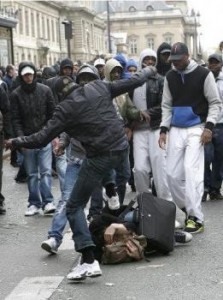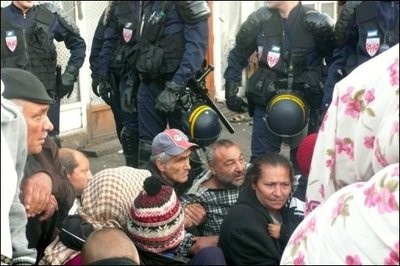Quinze ans après le fameux slogan de campagne de Jacques Chirac sur la « fracture sociale », où en sont les inégalités ? Le constat du géographe Christophe Guilluy dénonce l’incapacité de nos dirigeants à pallier les inégalités territoriales.

Il y a 15 ans maintenant, Jacques Chirac emportait l’élection présidentielle grâce à une intuition que résumait non pas son indigeste premier slogan « manger des pommes » mais le second, ô combien plus politique, dénonçant la « fracture sociale ».
Pour Christophe Guilluy, rien n’a vraiment changé en 15 ans. Au contraire, d’évitement en évitement, les cassures se sont approfondies, diffusées, multipliées, comme un cancer mal soigné se métastase.
Avec « Fractures françaises », son dernier essai, dont on peut lire quelques extraits ci-dessous, le géographe dresse un constat alarmiste sur la situation des couches populaires après 20 ans de mondialisation à marche forcée. Cette fois-ci, ce sera sans cartes, mais avec en appui un sérieux paquet de statistiques.
Car il s’agit ni plus ni moins pour ce chercheur que de dénoncer l’incroyable cécité des politiques publiques, à comprendre, apprécier, mesurer les inégalités territoriales qui se sont maintenant enkystées dans ce «vieux pays». Derrière ces territoires, ce sont évidemment des populations.
Alors que les dynamiques de mondialisation, de « métropolisation », et d’émergence du multiculturalisme à l’œuvre depuis deux voire trois décennies ont ébranlé le « principe d’égalité sociale ». Les réponses apportées ont à chaque fois tapé à coté de l’objectif, mainte fois répété, rarement atteint, de maintien des principes républicains.
La banlieue occulte tous les autres territoires
Cet aveuglement, les politiques l’ont en partage avec nombre d’acteurs de la sphère publique. Et d’abord les médias, comme on l’a encore vu récemment avec ces journalistes du Point abusés par leur « fixeur » de Montfermeil dans leur « enquête » sur la polygamie en banlieue.
S’il est vrai que se posent dans ces espaces des questions aussi sensibles que le « vivre-ensemble », comme viennent le confirmer les travaux du sociologue Hugues Lagrange sur la sur-délinquance, cette banlieue est, selon l’auteur, désignée à tort comme une terra incognita. Guilluy rappelle l’importance des travaux académiques qui lui sont consacrés comme des milliards d’argent public qui y sont dispensés.
Le problème est que la banlieue finit par occulter tous les autres territoires. Et par ricochet, la question sociale, pour le plus grand profit d’une droite sarkozyste qui a fait de l’insécurité son fonds de commerce, avec les (non-) résultats que mesurent parfaitement les statistiques.
Pour lui, un consensus « caricatural » s’est imposé : les banlieues concentrent tous les problèmes, sous-entendu il n’y en a pas ailleurs. Dit autrement : « l’idée d’une société française divisée entre les exclus, essentiellement les minorités qui vivent en banlieue, et la classe moyenne ».
A la faveur de ce discours, qualifié de dominant, disparaît donc la question de la relégation culturelle et spatiale (les grands espaces périurbains, au-delà des banlieues) des classes moyennes et populaires. A cette montée des inégalités monétaires, et surtout d’opportunité d’ascension, tant pour les français dits de souche que pour les immigrés, répond une politique centrée sur une analyse essentiellement communautariste.
La promotion de la diversité qui en découle aboutit aux rustines de la discrimination positive, déjà en place à l’ENA ou à Sciences-Po. Pourtant, comme le note l’auteur, « si les élites sont prêtes à s’ouvrir à la diversité ethnique, peu considèrent la diversité sociale, que remettrait en cause un système dont elles bénéficient, comme une priorité ».
Ces fractures françaises dessinent un territoire en recomposition, où seuls s’imposent les problèmes de la banlieue, que résoudraient à bon compte l’émergence d’une société dite multiculturelle. De leur déni nait le mythe d’une société apaisée au sein de laquelle s’épanouirait une classe moyenne majoritaire et bénéficiaire de la mondialisation.
En fait, le chômage de masse qui s’incruste depuis 30 ans, l’abstention massive, les inégalités de revenus qui s’accroissent, ou encore le fait que les masses populaires disparaissent des écrans radar des médias, invalident totalement cette analyse.
L’ouverture massive des frontières aux biens et aux personnes, qui élargissent ces « fractures françaises » demeure un invariant, dont l’élite profite indéniablement, quitte à faire voler en éclats le modèle républicain.
———————–
Extraits du livre « Fractures Françaises », du géographe Christophe Guilluy, chez François Bourin Editeur, 19 € :
Certaines thématiques structurent plus que d’autres le discours dominant. Depuis 1990, la banlieue, les minorités et la classe moyenne occupent ainsi l’essentiel du discours des prescripteurs d’opinions et, singulièrement, de la classe politique.
À aucun moment, la question de la pertinence de ces représentations sociales et territoriales n’a été posée ; celles-ci traduisent pourtant une interprétation très idéologique des oppositions sociales.
La remise en cause des représentations sociales de la société française n’est pas un exercice «technique», ni même un débat sociologique. Cette critique des représentations courantes permet d’interroger la pertinence des discours politiques, médiatiques et culturels, et d’identifier ainsi l’une des causes majeures de la fracture entre le peuple et ses élites.
La montée de l’abstention et du « populisme » est présentée comme un rejet du politique ou des partis. Elle est en réalité l’illustration d’un décalage croissant entre la réalité et les représentations qui influencent le discours des partis politiques.
On comprend, dans ce contexte, que 67% des Français ne fassent plus confiance ni à la gauche ni à la droite et que seulement une minorité d’entre eux arrivent encore à se situer sur l’échelle gauche/droite. Comment se sentir impliqué par un débat politique essentiellement centré sur des représentations erronées de la société française ?
La crise démocratique est d’abord celle d’une grille de lecture dépassée. La question des banlieues occupe une place de choix dans cette grille. Il s’agit certainement de la thématique la plus médiatisée et certainement la plus erronée. Elle s’articule avec celle des classes moyennes.
Ces deux thèmes ne sont pourtant jamais mis en relation. La littérature consacrée aux deux sujets est abondante, mais ne montre pas comment ces questions se nourrissent l’une de l’autre. Pourtant, l’une n’existe pas sans l’autre.
 Les quartiers sensibles se définissent ainsi comme des territoires désertés par les classes moyennes. L’image de ces « no-middle-class-land » s’est construite en creux, en comparaison d’une classe moyenne majoritaire et intégrée vivant sur d’autres territoires, notamment périurbains.
Les quartiers sensibles se définissent ainsi comme des territoires désertés par les classes moyennes. L’image de ces « no-middle-class-land » s’est construite en creux, en comparaison d’une classe moyenne majoritaire et intégrée vivant sur d’autres territoires, notamment périurbains.
Cette analyse caricaturale d’une société divisée entre les « exclus » et les « petits bourgeois », entre les cités et les pavillons, a été confortée par l’émergence de la thématique des minorités. Les exclus, ceux qui se concentrent dans les quartiers sensibles, font partie des minorités visibles, les classes moyennes appartenant mécaniquement à la majorité invisible.
L’opposition d’une France des ghettos ethnicisés à une France des pavillons permet de valider l’idée d’une société structurée par un apartheid urbain et ethnique. Peu importe que les banlieues ne soient pas les ghettos américains, que la France pavillonnaire ne soit plus celle de l’ascension sociale des classes moyennes, et que, au final, cette géographie sociale n’existe pas.
Cette construction sociologique et urbaine est désormais gravée dans le marbre politique et médiatique : des territoires et des populations qui ne seront jamais des classes moyennes, face à des territoires qui, au contraire, y sont fermement arrimés.
Cette doxa « sociospatiale » n’est pas seulement une posture médiatique, elle a des conséquences idéologiques profondes. Elle permet, nous le verrons, d’accompagner en douceur l’intégration à la mondialisation libérale en rendant obsolète la question sociale et ainsi, de remplacer peu à peu l’égalitarisme républicain par un «égalitarisme multiculturel», beaucoup moins exigeant socialement.
La déconstruction du discours sur la banlieue, les minorités et les classes moyennes, vise à remettre en cause une représentation idéologique de la société française, afin de discerner les véritables dynamiques à l’œuvre dans la société et sur les territoires.
En effet, « la banlieue » n’existe pas. Il ne s’agit évidemment pas là de remettre en cause l’existence de territoires urbains où vivent les trois quarts de la population urbaine. Il ne s’agit pas non plus de nier l’évidence d’une concentration des difficultés sur certains territoires où les taux de chômage et de pauvreté sont effectivement très élevés.
Il s’agit, en revanche, de nous interroger sur la signification du surgissement dans le discours politique du « ghetto à la française ». Stigmatisée et victimisée, la « banlieue-ghetto » participe à la construction d’une représentation erronée de la société française.
Hormis le fait qu’elle empêche de poser le véritable diagnostic des quartiers sensibles, elle masque l’importance des nouvelles dynamiques urbaines et sociales. La situation des banlieues est d’abord la conséquence de l’émergence d’une nouvelle géographie sociale insuffisamment prise en compte.
Une géographie médiatique
Ainsi, pour y voir plus clair, une petite leçon de géographie sociale s’impose. La transformation des villes, les évolutions économiques, la démographie modèlent insensiblement le paysage social.
La géographie sociale est aussi le fruit d’un héritage. Les représentations des territoires sont pour partie héritées de deux périodes : celle de la révolution industrielle et celle, plus récente, des Trente Glorieuses.
La vision dix-neuvièmiste des territoires oppose les quartiers ouvriers et les régions industrielles aux quartiers bourgeois et aux régions tertiairisées. Née de la révolution industrielle, cette géographie structure encore socialement le territoire.
Une autre est venue compléter ce dispositif, celle forgée durant les Trente Glorieuses (1945-1975). Cette géographie de la « moyennisation » est celle de la France pavillonnaire. Cette France périurbaine se confond avec la France des classes moyennes en voie d’ascension sociale.
Ces géographies sociales « héritées » s’effacent peu à peu dans les années 1980, pour laisser la place à une autre représentation sociale des territoires, celle des banlieues.
Contrairement aux autres, cette géographie-là est d’abord une « géographie médiatique » : « vu à la télé », modelé au fil des ans par la puissance médiatique des images, le paysage des quartiers sensibles s’est imposé à l’ensemble des prescripteurs d’opinions, avant même d’avoir fait l’objet d’une analyse sociale et scientifique sérieuse.
L’étude des dynamiques sociales pèse en effet peu, face aux images d’émeutiers armés de Villiers-le-Bel ou du quartier de la Villeneuve à Grenoble.
Ainsi, et pour la première fois, ce ne sont plus les seuls acteurs sociaux qui modèlent et écrivent l’histoire sociale, mais les médias et plus largement les prescripteurs d’opinions. Le traitement médiatique de la question des banlieues n’aura pas seulement contribué à créer de nouvelles représentations sociologiques, il est aussi à l’origine d’une géographie sociale qui structure désormais les discours politiques.
Il est ainsi frappant de constater la rapidité avec laquelle la géographie sociale traditionnelle s’est effacée. Les territoires de la France ouvrière, industrielle, l’histoire bicentenaire des quartiers populaires des grandes villes, sans parler de la France rurale… tout cela s’est évanoui peu à peu dans les années 1980-1990, au fur et à mesure qu’émergeait l’obsession des banlieues.
Cette disparition n’est pas seulement la conséquence du passage de la société industrielle à la société postindustrielle, mais participe à un mouvement idéologique qui vise notamment à substituer la question sociale à des questions sociétales. Ce qui est vraiment en cause ici n’est pas le traitement de la crise des banlieues par les médias, mais l’utilisation politique de ce traitement.
 Le « paysage médiatique » est devenu le « paysage social de référence » et le reflet de l’idéologie des élites. L’analyse de la genèse de cette représentation permet d’éclairer cette dimension idéologique.
Le « paysage médiatique » est devenu le « paysage social de référence » et le reflet de l’idéologie des élites. L’analyse de la genèse de cette représentation permet d’éclairer cette dimension idéologique.
Les urbanistes et sociologues ont l’habitude de faire démarrer la crise des banlieues et la politique de la ville en 1973. Les pouvoirs publics créent alors le premier groupe de réflexion sur les quartiers de grands ensembles de logements sociaux. Cette année de naissance est techniquement pertinente puisque l’attention portée aux grands ensembles va précéder les émeutes urbaines.
Cet acte de naissance marque une volonté, dès les années 1980, de « techniciser » et d’«urbaniser» une question qui est d’abord démographique, culturelle et idéologique. La banlieue comme « objet politique et médiatique » est née en septembre 1979, précisément dans la banlieue lyonnaise, à Vaulx-en-Velin.
Pour la première fois, des émeutes urbaines, que l’on croyait réservées aux pays anglosaxons ou à ceux du tiers-monde, venaient frapper le territoire français. Pendant plusieurs jours, les jeunes du quartier de la Grappinière multiplient les « rodéos », affrontent la police et incendient des voitures.
Pire, ces échauffourées sporadiques se multiplient et touchent d’autres communes et quartiers de la banlieue lyonnaise. Villeurbanne, notamment la cité Olivier-de-Serres, est touchée en 1980.
Un an plus tard, c’est au tour de Vénissieux et du quartier des Minguettes de subir des violences urbaines d’une rare intensité. Les politiques sont sous le choc, comme paralysés par des violences qui concernent une France qu’on ne connaît pas, celle des jeunes Français issus de l’immigration maghrébine. La banlieue, c’est d’abord une image, celle de ces jeunes Français qui défient la police.
Le choc est d’abord culturel, et non pas urbain. Ces événements seront d’ailleurs le point de départ en 1983 de la « Marche civique pour l’égalité et contre le racisme », baptisée « Marche des Beurs » par les médias, dont les revendications sont sociales et culturelles ; la question urbaine et celle des violences n’apparaissent qu’en second plan.
Le traitement médiatique et politique de ces événements modèle assez rapidement l’image-type d’un paysage angoissant, celui de grands ensembles de logements sociaux, souvent dégradés et où les violences sont récurrentes. Le discours sur l’« urbanisme criminogène » prend le pas sur la question sociale et culturelle.
La loi d’orientation pour l’aménagement et le développement du territoire définira, en 1995, ces quartiers difficiles comme des « zones sensibles se caractérisant par la présence de grands ensembles ou de quartiers d’habitat dégradés ».
Plus tard, sur un même registre, on évoquera la question de la « concentration des difficultés », l’idée étant toujours d’aborder le sujet à travers un prisme urbanistique, qui suggère qu’il existe une volonté politique de concentrer les populations issues de l’immigration maghrébine dans des ghettos.
La sur-représentation, depuis trente ans, des banlieues difficiles, non seulement dans les médias mais aussi dans le monde de la recherche, impose alors le ghetto comme le paysage emblématique de la crise de la société française. La thématique banlieusarde est désormais omniprésente.
Sur le sujet, la littérature, notamment sociologique, est prolifique. Il n’y a désormais plus un seul quartier sensible qui n’ait échappé à sa thèse, à sa recherche urbaine, plus un seul îlot qui ne vive en permanence sous l’œil d’un observatoire local ou national. On connaît tout, absolument tout de ces territoires les plus étudiés de France ; de l’immeuble à l’îlot, rien n’échappe à l’analyse.
Paradoxalement, cette attention extrême ne semble pas remettre en cause l’idée selon laquelle la banlieue resterait une « terra incognita » ; une idée très répandue, qui permet au passage de faire perdurer la production de reportages, sous prétexte d’investigations inédites ou de nouvelles recherches.
Cette attention générale impose de fait les quartiers difficiles dans l’agenda des politiques. Pour l’année 2008, le journal Le Monde avait relevé que le seul département difficile de la Seine-Saint-Denis avait ainsi enregistré 174 déplacements ministériels.
Il n’y a pas que des jeunes en banlieue, et il y a aussi des jeunes ailleurs !
On pourrait expliquer cette exploration en continu des quartiers difficiles, par l’intérêt pernicieux de médias pour des territoires qui font vendre. L’explication est un peu courte.
En réalité, cette attention médiatique est provoquée par le fantasme d’une classe dirigeante persuadée d’être face à l’apparition en France du « ghetto black américain » et d’une jeunesse rebelle issue des minorités ethniques : la France est désormais face aux jeunes du ghetto.
Problème, la banlieue française n’est pas le « ghetto black ». La jeunesse agitée et en décrochage des quartiers ne représente qu’une faible minorité des habitants.
La question de la médiatisation de cette jeunesse des banlieues pose plusieurs questions. La première tient à la réduction de la population des quartiers sensibles aux seuls jeunes, alors que la majorité de la population est composée d’adultes et de personnes âgées. Bref, les banlieues vieillissent aussi.
Les quartiers classés « sensibles » ne sont pas en effet des « fontaines de jouvence ». Sur ces territoires, le vieillissement des populations n’est jamais évoqué. Si les adultes sont invisibles, les retraités n’existent pas. La part des plus de 60 ans progresse, en fait, rapidement dans la plupart des quartiers sensibles, avec une « tendance à un rapprochement de la pyramide des âges des ZUS à celle de la France entière ».
En banlieue, il semble malgré tout que les jeunes restent toujours jeunes. On peut pourtant raisonnablement imaginer que, biologiquement, les jeunes qui ont pris part aux émeutes de 1979 à Vaulx-en-Velin ont désormais près de 50 ans. Traînent-ils encore en bas de leurs immeubles ? Brûlent-ils encore des voitures ? Plus certainement, ils ont, a priori, fondé des familles, travaillent, et, pour beaucoup, ont quitté le quartier de la Grappinière.
L’association mentale « jeunes de banlieues » est si forte, qu’il convient de rappeler une vérité qui s’applique y compris sur ces territoires : on vieillit aussi en banlieue ! Les jeunes d’aujourd’hui ne sont pas ceux d’hier et ne seront pas ceux de demain.
Rappeler cette évidence n’est pas inutile, à un moment où le jeunisme est devenu une valeur dominante et que la fascination (entre attraction et répulsion) du monde médiatique et politique pour la « jeunesse des banlieues » semble truster toute réflexion sur les autres tranches d’âge.
Le vieillissement dans le parc social est pourtant devenu un sujet de préoccupation pour l’ensemble des bailleurs sociaux. Le « papy-boom » des banlieues est en marche et le nombre de retraités pauvres, déjà en augmentation, risque de progresser très rapidement dans les prochaines années.
La réduction de la banlieue à la jeunesse tend également à imposer l’idée d’une réduction de la jeunesse à celle des banlieues.
En 2006, Jean-Louis Borloo, alors ministre de l’Emploi, de la Cohésion sociale et du Logement, déclarait qu’il fallait « bien que les Français aient en tête une chose, c’est que l’avenir du pays se joue là ». Cette affirmation pose deux problèmes.
Le premier est de considérer que 8 % de la population résume l’avenir d’un pays. Par ailleurs, si la part des moins de 20 ans est effectivement plus élevée en ZUS (30%, contre 25% en moyenne en France), elle ne cesse de diminuer depuis 1990, au profit des plus de 60 ans dont le nombre a fortement augmenté dans ces quartiers depuis vingt ans.
Le deuxième est de se persuader que la jeunesse relative des banlieues et, au-delà, des populations issues de l’immigration, pourra infléchir un processus de vieillissement qui, rappelons-le, est un processus inéluctable et quasiment mondial.
Ce discours est caractéristique de l’amnésie française qui, après avoir oublié la classe ouvrière et plus généralement les catégories populaires, est dans l’impossibilité désormais de concevoir une autre jeunesse, par exemple celle des espaces périurbains et ruraux, que celle, « vue à la télé », des quartiers sensibles.
L’affirmation selon laquelle la jeunesse des quartiers sensibles serait l’avenir de la France est évidemment généreuse, mais elle pose quelques questions de fond.
La première est qu’affirmer que les quartiers sensibles, c’est-à-dire les territoires où les violences urbaines et aux personnes sont plus fréquentes, constituent l’avenir de la France, est particulièrement anxiogène pour l’ensemble de la société.
De la même manière, considérer que les jeunes des quartiers sensibles sont emblématiques de la jeunesse issue de l’immigration, alors même qu’une minorité d’entre eux vivent dans ces quartiers, participe à la construction d’une représentation négative de l’ensemble des jeunes issus des minorités.
On le voit, la démagogie sur la « jeunesse des quartiers » se révèle contre-productive, notamment au regard de l’objectif recherché, celui de favoriser l’intégration et de promouvoir une image positive des minorités.
Cette représentation négative est renforcée par une utilisation sans modération du concept de ghetto pour décrire la réalité des banlieues françaises.
A Villiers-le-Bel, 12 000 € par habitant, près de Verdun… 11 €
En l’espace de quelques décennies, l’histoire urbaine et sociale de ces territoires a laissé la place à une représentation « à l’américaine », celle qui oppose le ghetto ethnicisé au reste de la société.
La grille de lecture de la réalité banlieusarde est fondamentalement anglo-saxonne et américaine. Le modèle du ghetto américain a été d’autant plus rapidement adopté qu’il permet d’évoquer la crise des sociétés urbaines et multiculturelles.
On peut s’étonner de la rapidité avec laquelle l’intelligentsia française, pourtant critique à l’égard du modèle anglo-saxon, a adopté une telle grille de lecture pour décrire une réalité sociale. S’il existe une Amérique racialiste qui rejette la communauté noire, la France ferait émerger une « société d’apartheid », affirme la bien-pensance. Ce discours apparaît comme une critique à peine voilée du modèle républicain et égalitaire que nous connaissons.
L’idée de la ghettoïsation « à l’américaine » suggère, en effet, que l’État républicain a déserté ces territoires. Stigmatisées, reléguées, les banlieues seraient ainsi sous-équipées et l’État y serait moins présent qu’ailleurs.
 Cette affirmation ne correspond pas à la réalité. Si la permanence des difficultés sociales révèle une forme d’impuissance des pouvoirs publics, elle ne signifie pas pour autant que l’État s’est désengagé. D’ailleurs, ces territoires bénéficient le plus souvent d’une densité d’équipements publics supérieure à celle des territoires périurbains et ruraux.
Cette affirmation ne correspond pas à la réalité. Si la permanence des difficultés sociales révèle une forme d’impuissance des pouvoirs publics, elle ne signifie pas pour autant que l’État s’est désengagé. D’ailleurs, ces territoires bénéficient le plus souvent d’une densité d’équipements publics supérieure à celle des territoires périurbains et ruraux.
C’est dans cette optique que le sociologue Dominique Lorrain a réalisé une étude comparative sur les investissements publics entre le quartier des Hautes-Noues à Villiers-sur-Marne et un quartier de la périphérie de Verdun.
Dans les deux cas, les populations concernées sont modestes et/ou précaires et les taux de chômage sont élevés. La cité des Hautes-Noues est classée « sensible », tandis que le quartier de la périphérie de Verdun n’a jamais fait parler de lui.
Première surprise, le revenu moyen par habitant du quartier sensible de Villiers-sur-Marne est de 20% supérieur à celui de Verdun. L’auteur précise par ailleurs que les équipements culturels, les services publics et les facilités de transports sont moins fournis à Verdun : il faut compter trois heures pour rejoindre la métropole nancéenne, contre vingt minutes pour rallier Paris depuis le quartier des Hautes-Noues.
Enfin, et pour faire litière de l’idée d’un abandon des quartiers sensibles, le chercheur calcule le total des investissements publics par habitant. Le programme de réhabilitation dont bénéficie le quartier des Hautes-Noues prévoit une dotation de 12 450 euros par habitant, tandis que le contrat de ville mis en place dans les quartiers de Verdun n’alloue que 11,80 euros par habitant.
Les investissements publics étaient donc mille fois plus élevés dans le quartier sensible que dans les quartiers de Verdun, pourtant socialement défavorisés !
Cet exemple, extrême, n’est certainement pas représentatif de la situation qui prévaut sur l’ensemble du territoire, mais vise, a minima, à démontrer, qu’à situation sociale égale, les pouvoirs n’ont pas choisi d’abandonner les ghettos. Au contraire, ces territoires jouissent pleinement d’une forme de discrimination positive.
L’accentuation des opérations de démolitions-reconstructions, initiées depuis 2004, confirme la poursuite de ces investissements massifs : environ 40 milliards d’euros seront investis, d’ici à 2013, pour la rénovation urbaine de ces quartiers.
La banalisation de l’« émeute urbaine »
Concernant les banlieues, la réalité des faits pèse peu face au bruit médiatique. Les relances en matière de politique de la ville ne sont pas l’aboutissement d’une pression syndicale ou d’un mouvement social, mais sont toutes consécutives à des périodes de tension ou d’émeutes urbaines médiatisées.
Sans diagnostic, sans interlocuteurs représentatifs et face à des émeutes toujours plus spectaculaires, les pouvoirs publics initient des politiques qui ne sont pas des réponses à une « demande sociale », mais d’abord une réaction à une « demande médiatique ». Les émeutes de 2005 ont, par exemple, contribué à accélérer la mise en place d’une politique de discrimination positive.
Depuis les années 1980, les pouvoirs publics réagissent aux émeutes comme s’ils étaient face à un mouvement social structuré. Cette confusion entre délinquance et revendication sociale tend à légitimer la violence.
Tout se passe comme si le système considérait l’« émeute urbaine » comme un mode d’expression sociale acceptable, destiné à remplacer une médiation traditionnelle, quasi inexistante sur ces territoires. Cette légitimation des violences participe fortement à la construction du stéréotype du jeune de banlieue.
La violence d’une minorité de délinquants est ainsi associée au mode de revendication de prédilection des jeunes banlieusards et, même, d’une majorité des habitants. Pire, l’association violence et jeunes issus de l’immigration maghrébine et subsaharienne est pour partie indirectement validée par les pouvoirs publics.
Parce qu’elles se déploient comme une réponse aux violences médiatisées, les politiques publiques sont aussi des opérations de com. Les opérations de démolitions-reconstructions entrent pour partie dans cette logique.
La question sociale, pourtant déterminante comme on l’a vu, est le plus souvent délaissée pour donner la priorité à ce qui se voit. La manne de l’argent public investi dans les banlieues bénéficie ainsi plus aux entreprises de BTP et aux agences d’architecture qu’aux habitants.
Les opérations de démolitions-reconstructions, qui entretiennent l’illusion de faire disparaître les difficultés, n’ont qu’un impact social limité. Elles donnent parfois l’opportunité à certains maires de disperser quelques familles immigrées, souvent africaines, dans des communes ou quartiers mitoyens, mais ne traitent aucune question de fond.
Le comité d’évaluation et de suivi de l’Anru a confirmé que les opérations de démolitions-reconstructions n’ont fait évoluer la population qu’à la marge puisque, dans les faits, 68% des nouvelles habitations sont construites en zone urbaine sensible (ZUS) et près de la moitié dans la même commune.
Ces opérations, souvent contestées par les habitants, représentent une forme d’apogée de la réponse politico-médiatique. Il s’agit de démontrer à l’opinion (surtout celle qui vit à l’extérieur des quartiers) que « les choses bougent » par la volonté politique. Quoi de plus médiatique qu’une démolition d’immeuble qui, de plus, permet à l’État de réaffirmer une forme d’autorité largement perdue sur ces territoires ?
Les opérations policières sont à ce titre exemplaires d’une politique «sous influence médiatique». Les services de police sont ainsi régulièrement mis à contribution dans le montage d’opérations « coup de poing », dont tous les criminologues expliquent qu’elles ne servent strictement à rien sur le plan sécuritaire.
L’absence de structures représentatives des habitants, et donc de contre-pouvoirs, laisse ainsi la place à des opérations médiatiques, peu en phase avec la réalité sociale. Ce déficit n’est malheureusement pas compensé par une représentation municipale qui, le plus souvent, n’est élue que par une fraction très minoritaire d’une population qui ne prend plus guère part aux élections.
Aux municipales de 2008, le maire de La Courneuve a été élu avec 3665 voix, ce qui représente 49% des suffrages exprimés, mais 26% des inscrits et 9,6% de l’ensemble de la population totale. Ce vide démocratique favorise, au final, le développement de politiques dont l’influence sur le réel sera faible.
Le piège de la médiatisation s’est peu à peu refermé sur la banlieue et ses habitants. Un point d’orgue a été atteint en 2005, où les « experts » invités à commenter la situation étaient le plus souvent issus du monde médiatique. Le seul fait de vivre ou d’avoir vécu en banlieue suffisait alors à rendre crédible l’« analyse ». Cette « illusion biographique » permet de crédibiliser le spectacle.
Après les rappeurs, un degré supplémentaire dans le ridicule fut atteint par la presse, qui sollicita sans retenue l’expertise du comique Jamel Debbouze. On allait enfin comprendre. Cette « pipolisation » de l’expertise de la question des banlieues parachève un processus de substitution de la question sociale et démographique, au profit de l’analyse médiatique.
Un phénomène qui touche moins d’autres territoires ou populations. Malgré leurs origines populaires, on n’a jamais demandé à Gérard Depardieu ou à Jean-Marie Bigard de commenter les délocalisations industrielles ou la dégradation des conditions de travail de la classe ouvrière.
Marianne2
(Tous les liens insérés dans cet article, l’ont été par fortune.fdesouche.com)
 Two weeks ago the first “gay pride parade” was staged in Belgrade. Serbia’s “pro-European” government had been promoting the event as yet another proof that Serbia is fit to join the European Union, that is has overcome the legacy of its dark, intolerant past. Thousands of policemen in full riot gear had to divide their time between protecting a few hundred “LBGT” activists (about half of them imported from Western Europe for the occasion) and battling ten times as many young protesters in the side streets.
Two weeks ago the first “gay pride parade” was staged in Belgrade. Serbia’s “pro-European” government had been promoting the event as yet another proof that Serbia is fit to join the European Union, that is has overcome the legacy of its dark, intolerant past. Thousands of policemen in full riot gear had to divide their time between protecting a few hundred “LBGT” activists (about half of them imported from Western Europe for the occasion) and battling ten times as many young protesters in the side streets.




 del.icio.us
del.icio.us
 Digg
Digg Deux aspects :
Deux aspects :


 Qualcosa o qualcuno si agita nelle bianche distese del continente antartico; una presenza non umana, prigioniera di sogni indicibili. Ciò che scrivevano
Qualcosa o qualcuno si agita nelle bianche distese del continente antartico; una presenza non umana, prigioniera di sogni indicibili. Ciò che scrivevano 








 The Futurists were contemptuous of all tradition, of all that is past:
The Futurists were contemptuous of all tradition, of all that is past:




 The
The 





 Les quartiers sensibles se définissent ainsi comme des territoires désertés par les classes moyennes. L’image de ces « no-middle-class-land » s’est construite en creux, en comparaison d’une classe moyenne majoritaire et intégrée vivant sur d’autres territoires, notamment périurbains.
Les quartiers sensibles se définissent ainsi comme des territoires désertés par les classes moyennes. L’image de ces « no-middle-class-land » s’est construite en creux, en comparaison d’une classe moyenne majoritaire et intégrée vivant sur d’autres territoires, notamment périurbains. Le « paysage médiatique » est devenu le « paysage social de référence » et le reflet de l’idéologie des élites. L’analyse de la genèse de cette représentation permet d’éclairer cette dimension idéologique.
Le « paysage médiatique » est devenu le « paysage social de référence » et le reflet de l’idéologie des élites. L’analyse de la genèse de cette représentation permet d’éclairer cette dimension idéologique. Cette affirmation ne correspond pas à la réalité. Si la permanence des difficultés sociales révèle une forme d’impuissance des pouvoirs publics, elle ne signifie pas pour autant que l’État s’est désengagé. D’ailleurs, ces territoires bénéficient le plus souvent d’une densité d’équipements publics supérieure à celle des territoires périurbains et ruraux.
Cette affirmation ne correspond pas à la réalité. Si la permanence des difficultés sociales révèle une forme d’impuissance des pouvoirs publics, elle ne signifie pas pour autant que l’État s’est désengagé. D’ailleurs, ces territoires bénéficient le plus souvent d’une densité d’équipements publics supérieure à celle des territoires périurbains et ruraux.
 Paul Gottfried has spent the last thirty years writing books and generating hostility among authorized media-approved conservatives. His most recent work is his autobiography Encounters; and he is currently preparing a long study of Leo Strauss and his disciples. His works sell better in Rumanian, Spanish,Russian and German translations than they do in the original English, and particularly in the Beltway. Until his retirement two years hence, he will continue to be Raffensperger Professor of Humanities at Elizabethtown College in Elizabethtown, PA.
Paul Gottfried has spent the last thirty years writing books and generating hostility among authorized media-approved conservatives. His most recent work is his autobiography Encounters; and he is currently preparing a long study of Leo Strauss and his disciples. His works sell better in Rumanian, Spanish,Russian and German translations than they do in the original English, and particularly in the Beltway. Until his retirement two years hence, he will continue to be Raffensperger Professor of Humanities at Elizabethtown College in Elizabethtown, PA.



